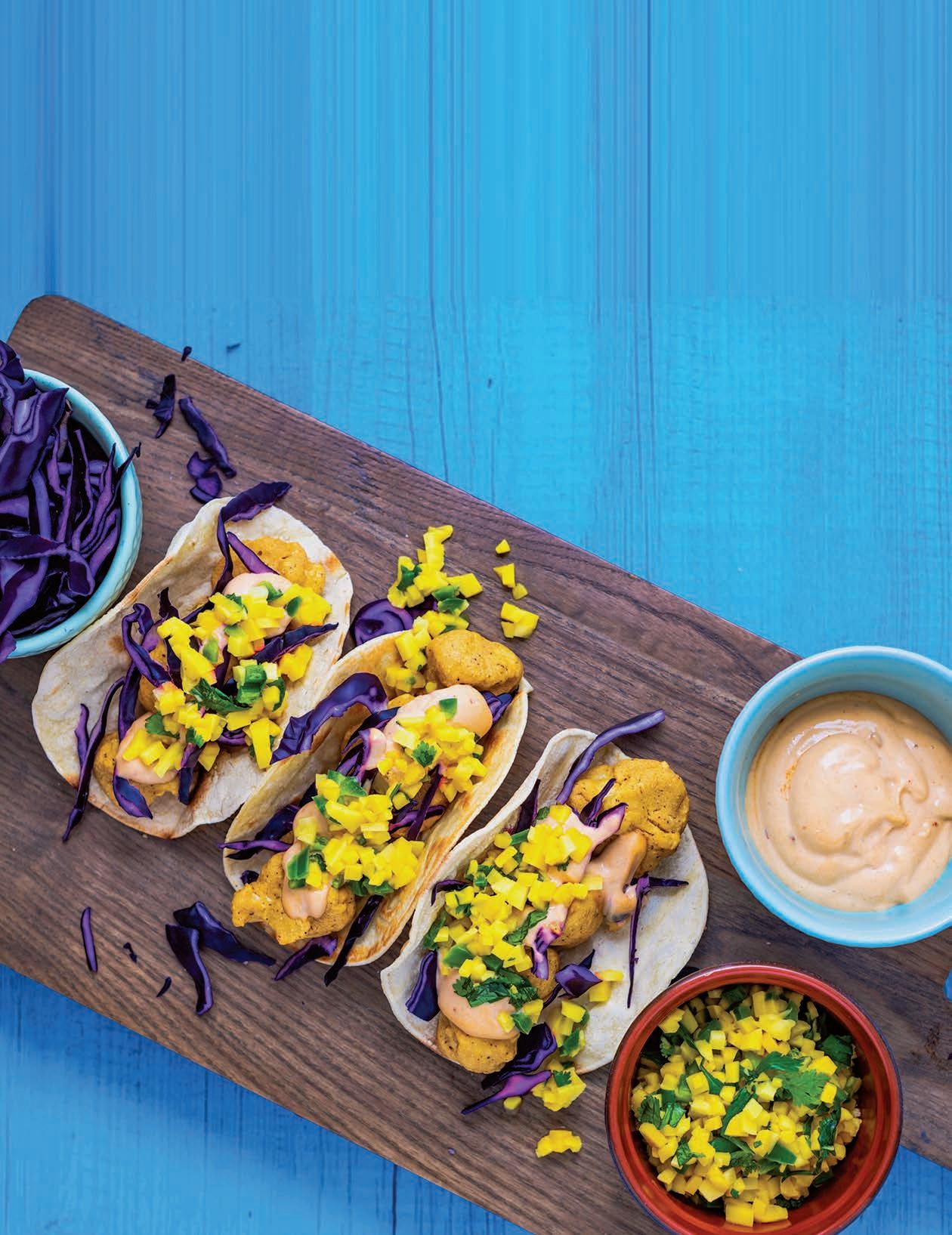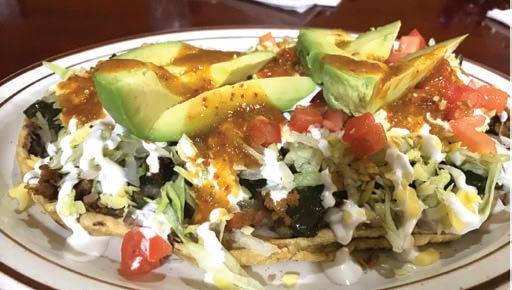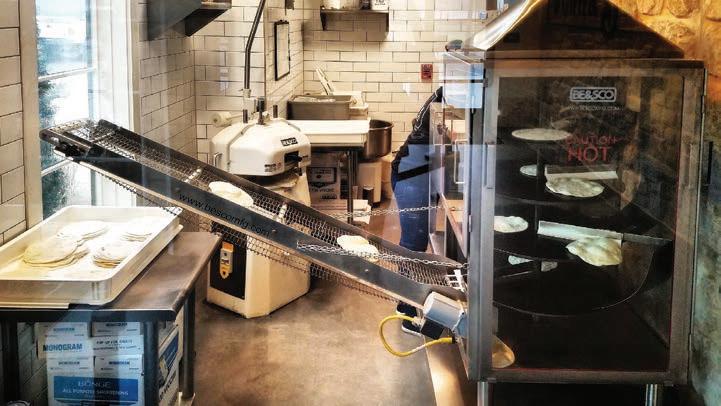
11 minute read
COVER STORY — Now Blooming: Plant-based Menus
NOW BLOOMING:
plant-based menus
Baja Cauliflower Tacos
CHEF EDDIE GARZA PHOTO BY STEVEN SEIGHMAN

| BY KATHLEEN FURORE | The Google reviews are in. And many of the rave reviews of the cuisine at Chicago’s La Esperanza Restaurant tout its vegan cuisine.
“Solid vegan menu with tons of variety...the flautas with vegan meat are my personal favorite with a side of nopales...”
“Better vegan fare than more vegan restaurants in Chicago...Ask for the Plant-Based Menu.”
“Had the vegan pozole with jackfruit, it was delicious!”
One look at the page full of La Esperanza’s plantbased options and reasons for the accolades become clear: It’s a comprehensive offering that includes burritos, enchiladas, flautas, quesadillas, gorditas, sopes, huaraches, nachos, tacos, tortas and pozole made with the customer’s choice of soyrizo, vegan meat, hibiscus birria, cactus, mushrooms, beans and avocado and jackfruit.
While it might seem surprising that plant-based dishes rank among favorites from an authentic Mexican restaurant located in Chicago’s Pilsen neighborhood, which is rich in Latino culture and culinary traditions, chefs and consultants alike says plant-based cuisine’s time has arrived.
“Plant-based alternatives are popping up on menus across the U.S. and beyond.

Restaurants are creating vegan version of ceviche similar to this California Walnut Ceviche with Marquesitas
PHOTO COURTESY OF CALIFORNIA WALNUT BOARD (WALNUTS.ORG)
— JAN MENDELSON, La Puerta Azul
But this top food trend has been a long time coming,” says Chef Eddie Garza, a plant-based chef, cookbook author, and host of “Global Bites with Eddie Garza” on OzTube, who has been a proponent of the plantbased movement for many years. “In 2018, I partnered with one of the most exclusive luxury hotels in Guanajuato, Mexico — Casa Del Rector — where we developed a series of plant-based menu items for each of the hotel’s dining establishments to keep up with patrons’ demands.”
Restaurant consultant Henry Dominguez, the president and CEO of FoodPro Restaurant Consulting, also sees a move toward this trend.
“I am adding more plantbased options to menus,” reports Dominguez, who works with Mexican, TexMex and other concepts on tasks such as recipe and menu development. “Customer requests are driving decisions to add plant-based options.”
La Esperanza’s Vegan Huarache with rajas and vegan meat
NOW SERVING...
The nice thing about plantbased dishes is that they can work on most any concept’s menu, from casual restaurants to high-scale establishments and everything in between.
Take the menus Garza created for Casa Del Rector.
“At the hotel’s cafe, you’ll find a plant-based version of the iconic Mexican breakfast sandwich the mollete, featuring house made chickpea ‘chorizo’ and cashew ‘cheese’ among other local favorites done in a plant-based way,”
“We have established a vegan, plant-based appetizer menu similar to our regular restaurant menu that allows couples to have basically the same items, but one being plant-based. In doing so, we have found that some of our ‘meat eating’ customers who have tried them have come to enjoy the plant-based options equally well.”
– JERRY MULLANE, Pig Daddy’s BBQ
Garza says. “At its fine dining restaurant, we developed a seasonally rotating plantbased chile relleno, locally sourced jackfruit tacos al pastor, and an array of plantbased small plates, including a delightfully sweet and tart shiitake mushroom and mango ceviche — a house favorite.”
A version of Garza’s Baja Cauliflower Tacos is on the menu at Hotel Los Ángeles in Chiapa de Corzo, Mexico, another Mexican establishment he partnered with in 2018. “There, you’ll also find a plant-based version of the regional dish cochito, featuring hyper locally sourced jackfruit from a neighboring jackfruit plantation,” he says. “Having worked with both of these establishments on paving the way for a plantbased future is one of the highlights of my career.”
At La Puerta Azul in Milbrook, New York, owner Jan Mendelson has added vegetarian items including vegetable burritos, tacos, enchiladas, quesadillas, and portobella mushroom fajitas — some that can be made vegan on request. “All of the vegetable items are popular,” says Mendelson, who notes that he’s experimented with both house-made and commercial veggie burgers, as well as Impossible Burgers, on the menu. And while there is “little demand” for those items, a portobello burger, with the mushroom replacing the patty, sells well, he adds.
Although the restaurant sits in a rural area where most customers are “fairly meat centric,” Mendelson says he has seen an increasing demand for vegetarian items, although it remains small.
“Our existing vegetarian customers do express an interest in more variety, and we try to address that through specials, for example roasted winter vegetable enchiladas with a chipotle-peanut salsa,” he says.
And speaking of meat-centric — even Pig Daddy’s BBQ in Drexel Hill, Pennsylvania, is experiencing an uptick in requests for plant-based items, according to owner Jerry Mullane.
“We have established a vegan, plant-based appetizer menu similar to our regular restaurant menu that allows couples to have basically the
Three-Way California AvoTacos, PHOTO COURTESY OF CALIFORNIA AVOCADO COMMISSION (continued on page 16)

Plant-based Dining: A Data-Backed Trend
According to the Plant Based Foods Association (PBFA), U.S. retail sales of plant-based foods continued to increase by double digits in 2020, growing 27 percent and bringing the total plantbased market value to $7 billion. This growth in dollar sales was consistent across the nation, with more than 25 percent growth in every U.S. census region. Plant-based foods sales have grown 43 percent in the past two years — nine times faster than total food sales. In 2020, 57 percent of all U.S. households purchased plant-based foods (that’s over 71 million households), up from 53 percent in 2019.
According to Mintel, 63 percent of U.S. consumers between the ages of 24 and 39 believe their nutritional needs can be fully met with a plant-based diet.
Data shows the movement is making its way into restaurant kitchens, too.
According to a recent report from food and beverage market research firm Tastewise, alt-meat is now mentioned 1320 percent more frequently on restaurant menus than before the pandemic and plant-based meat is now valued at $1.4 billion. The report reflects the findings of a study last year, which found that 9.7 million Americans now eat a plant-based diet.
The National Restaurant Association’s annual What’s Hot 2022 Culinary Forecast also highlights the trend. “Plant-based proteins are growing increasingly popular on menus...[and] foods that are believed to have immunity-boosting qualities and plant-based sandwiches make up three of the Top 10 Trends for 2022,” the report says.
(continued on page 14) same items, but one being plant-based,” he explains. “In doing so, we have found that some of our ‘meat eating’ customers who have tried them have come to enjoy the plantbased options equally well.”
Best-sellers, he reports, are vegan tacos with Briskket, Pulled Porc and Chikon; nachos made with Chikon, Pulled Porc, or Loaded (with Chikon, Porc and Chorisso) and Vegan Flatbread with Porc and Chorisso. What is driving Mullane’s decisions to add these items? “First, customer requests. Second, popularity within the community. And third, internet and TV advertising,” he says.
THE PROFIT POTENTIAL
Not only are plant-based dishes healthier for people and the planet; they can be healthier for restaurants’ bottom line, too, restaurateurs report.
“The profit impact is great!” says Dominguez. “Cost of sales for plant-based items are 23 percent to 27 percent.”
“In our particular restaurant, our biggest cost/least profitable items are meatbased menu items,” Mullane says. “Plant-based menu items can be up to 50 percent lower in cost and have a higher selling price for similar, same size portions.”
“Vegetarian dishes generally have lower food costs and higher profitability than meatbased options, especially with the ongoing increases in meat prices,” Mendelson echoes, but adds one caveat: “With low demand, they make a relatively small contribution to profitability overall.”

Where to Begin?
GETTING STARTED
Restaurateurs who have added plant-based items have suggestions for others who are just getting started. Customer input, all say, is key.
“I think the best place to start is always listening to your customers. If some customers are asking for something, try it out and see if it has more general appeal,” Mendelson suggests. “If customers have not expressed an interest in plant-based alternatives, try plant-based interpretations of some more popular menu items and see if there is any demand. While it may seem appealing to try and follow the trend, you need to balance the increased inventory and labor involved in adding plant-based options with the increased profitability of such items. If there isn’t sufficient demand, the costs may outweigh the benefits.”
Dominguez agrees that getting input from customers is crucial, and advises asking team members for input, too. “Then feature one [new] item per day for four weeks,” he says. “Focusing on only one item allows team members to learn the product, and cooks learn how to make one item at a time.”
Once that experiment is over, Dominguez suggests adding the three most popular items to the menu while continuing menu development and team training.
Mullane approaches the task this way: “Ask your customers if they would be interested in your establishment offering an alternative to your regular menu. But do not suggest these items would be healthier than your current offerings. This could be shooting yourself in the foot. Just say you would like to offer an option if they would be interested.” Starting with the appetizer menu first is Mullane’s
“Getting started with plant-based menu alternatives doesn’t have to involve a complete menu overhaul,” information from the restaurant supply app Cheetah explains. “Start small to test demand and gradually grow your plant-based menu items according to diners’ preferences.” #1 Start with one plant-based menu option. Add one meatless dish to your specials menu and see how your customers react. A good place to start is a vegetarian winter soup or meatless taco. If demand and reactions are positive, you can gradually explore more options. Be mindful of taste and texture. Diners who choose alt-meat say that these are as important to them as health. #2 Keep it simple. Choose something that your wholesale supplier can support and your back-of-house staff can easily integrate. #3 Make marketing matter. Communicate your new plantbased dish to customers through your website and social accounts. Let diners know that your restaurant is here to look out for their health and palate. Prepare your staff with a one liner like, “I love that dish. It is filling and juicy. I bring it home for my family when I can.”
— gocheetah.com
— CHEF EDDIE GARZA
What Does Plant-based Really Mean?
Adding plant-based dishes to restaurant menus is definitely a trend — but there seems to be some confusion as to what qualifies.
The menu at La Puerta Azul in Milbrook, New York, for example, features several vegetable-based dishes. But owner Jan Mendelson says he doesn’t offer what he thinks of as “plant-based options in the modern sense — things like jack fruit carnitas and chicharron de harina.” Forks Over Knives sums it up this way: “Plant-based is food that comes from plants and is free of animal ingredients such as meat, milk, eggs, or honey.”
The organization (which works to empower people to live healthier lives by changing the way the world understands nutrition) goes on to explain the differences between plant-based and vegan diets.
“A plant-based diet predominantly consists of plants; most people use the term to refer to a 100 percent plant diet, but some people include small amounts of animal products. A vegan diet totally eliminates all animal products.” A vegan diet also can include highly processed imitation meats and cheeses, information from Forks Over Knives says.
Below is a quick overview of the major food categories that can comprise plant-based menu items: • Fruits: Any type of fruit including apple, bananas, grapes, strawberries, and citrus fruits

• Vegetables: Plenty of veggies including peppers, corn, lettuce, spinach, kale, peas, collard greens • Tubers: Root vegetables like potatoes, carrots, parsnips, and sweet potatoes • Whole grains: Grains, cereals, and other starches in whole form, such as quinoa, brown rice, whole wheat, oats, popcorn • Legumes: Beans of any kind, plus lentils and pulses — forksoverknives.com
preference; he says it will reveal if your customer base will embrace a plant-based menu. “As I said, we had a lot of couples with one diner who suggested they would enjoy their experience more if they could eat similar plant-based menu items as their partner enjoyed our regular meat-based menu,” he concludes.
See recipes for Chef Garza’s Baja Cauliflower Tacos, California Walnut Commision’s Ceviche with Mariquitas, and California Avocado Commission’s Three Way California AvoTacos on pages 53-55.
Kathleen Furore is the editor of el Restaurante.
The Culinary Institute of America Announces Global Plant-Forward Culinary Summit
Presented by The Culinary Institute of America, which coincides with the launch of CIA’S Plant-Forward Kitchen education and digital media initiative, the summit will provide the opportunity to learn how to infuse your menu with plant-forward choices; gain insights into winning menu strategies; and receive dozens of new globally inspired plant-forward recipes.
plantforwardkitchen.org/gpfcs












